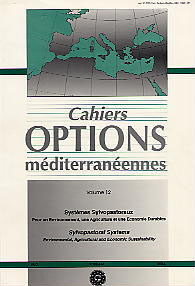| Article précédent | p. 179-182 | Article suivant |
Functioning of a sylvopastoral system based on different resources, including firebreak lines utilized by sheep
A trial has been carried out for six years in a Mediterranean environment of Central Italy, to evaluate the possibility of joining different forage resources into complex sylvo-pastoral systems. The different resources were lucerne, subterranean clover, Eragrostis curvula and an oak coppice, either with or without firebreak lines. At the end of the trial an average year has been compared with years having dry autumn or rainy and warm spring. The main results have been the possibility of using lucerne as seed crop in the favourable year, the possibility of reducing grazing into the wood by keeping the animals on the warm season grass or, above all, in the firebreak lines. Forage availability shown in the same graphic together with the needs of the animals can help in deciding the resource to be utilized. In conclusion, combinations of some resources present a flexible management with regard to the years, minimizing risks and wastes. Grazing of firebreak lines gives protection to fragile resources (wood) and to the less long-lived ones (lucerne).
- [ Afficher ]
- [ Télécharger ]
- [ Exporter la citation ]
Vous pouvez télécharger la citation au format :
- [ Imprimer ]
-
Mots-clés
ERAGROSTIS CURVULA, LUZERNE, PRODUCTION, QUERCUS, SYSTEME SYLVOPASTORAL, TRIFOLIUM SUBTERRANEUM, VARIATION SAISONNIERECiter cet article
Talamucci P., Pardini A., Argenti G., Staglianò N. Functioning of a sylvopastoral system based on different resources, including firebreak lines utilized by sheep. Systèmes sylvopastoraux. Pour un environnement, une agriculture et une économie durables . Zaragoza : CIHEAM, 1995. p. 179-182. (Cahiers Options Méditerranéennes; n. 12). Réunion du Groupe de Travail Méditerranéen du Réseau Interrégional FAO/CIHEAM de Recherche et Développement sur les Pâturages et les Cultures Fourragères, 1995/05/29-1995/06/02, Avignon (France). http://om.ciheam.org/om/pdf/c12/96605514.pdf



